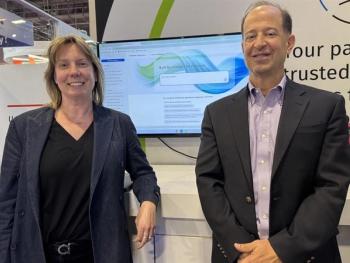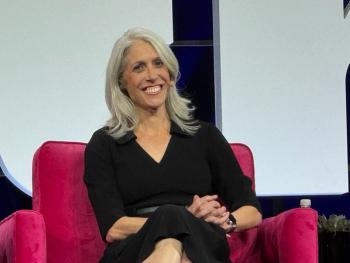
Making the Most of Real-World Data in Healthcare
Ad: For Don Woodlock, real-world data represent an opportunity waiting to be seized.
Every set of real-world data represents an opportunity for health systems and physicians to make better decisions. But each data set’s value depends on where it ends up on its journey from source to destination.
Does the data that would’ve prevented a readmission spend its lifespan siloed in a distant hospital’s electronic medical record (EMR), or does it surface at the point of care at the critical moment, empowering a physician to write a necessary prescription she might have missed otherwise?
That all depends on how prepared a health system is to capture, clean, and capitalize on real-world data. For Don Woodlock, it’s an opportunity that health systems can’t afford to miss.
Woodlock, head of the HealthShare Business Unit at InterSystems, explored use cases with real-world data before a crowd of several hundred attendees during HIMSS 2019 in Orlando, Florida. Here’s how he’s helping health systems make the most of their real-world data.
Let’s talk about patient-generated health data and other real-world healthcare data collected outside the health system. What are the implications of pulling all of this data into care, and how does it impact clinical care?
I mostly do business on the health systems side, and that’s a treasure trove of real-world patients generating real-world data. Our customers have hundreds of millions of patient records. They could be so useful in terms of trial feasibility, figuring out where to run a study, or how to tweak protocols to get higher likelihoods of success. I think it represents a powerful potential partnership between the health delivery side, where we’re generating this data, and the life sciences side, which could really use it.
There must be a big question around trusting this type of data. It is often generated outside the healthcare system, so you can’t necessarily trust what’s being pushed to you. How do we overcome this gap and how do we get providers to trust this data?
Data quality and governance are very important and so far, a lot of our customers hook up to the data sources and present it to a physician. The physician is a human, so they can deal with missing pieces of data and take what they want from it. But once you try to generate evidence from it or put it into logic, data quality really matters.
You have to be careful to mark all data with its source. The gold standard is when a physician or nurse input the data for the patient. That’s the kind of data we can usually rely on. But now we’re including payer data, claims data, social determinants of health (SDoH) data, patient IoT data and data from outside organizations that you may not trust as much as your own physicians. But here’s the thing: As long as the real-world data is tagged appropriately and you can handle the user experience challenges (and those are big challenges, by the way), you’re in an advantageous position. We have a good chance to make all of this data useful. But keep in mind that that doesn’t mean it’s necessarily incorporated or trusted equally in any decisions being made — at least not yet.
With the influx of so much data into health systems, we have to keep in mind that more data doesn’t always equal better decisions or outcomes. Can you talk more about that?
The quote I like on this data question is from one of our physician users. She said, “We’re looking for a needle in a haystack, and you IT people just keep on adding more hay.” We need to be quite careful because more is not better, and you have to take a very user-centric view and a question-oriented view as well. What is this person trying to figure out right now? What can help in the emergency department (ED) when a physician is treating a cardiac patient? That really narrows down what’s presented so the data can be very targeted and useful.
There are already high levels of burnout among clinical staff, so for some of our physicians out there, the idea of more data is probably scary — especially more real-world data, which we might not be able to trust. How do we relieve some of the stress and anxiety around that?
This is a big challenge, and here’s the key: We have to organize our work around these physicians. I think on this data aggregation question, sometimes we let our IT folks pile things into the EMR and we just hope for the best, even though nobody — certainly no doctors – really asked for that. So, it’s about taking that user-centric view and understanding that even though it’s not always true, more data can be really useful to a physician. It just has to be the right kind of data. For example, if I can find out the last five potassium values for a patient, that’d be great. But if I have to go through document after document to get that information, that’s not useful at all. Being more targeted and user centric is what it’s all about.
A simple example would be specialty-by-specialty views. If I’m a cardiologist and my patient has cardiac disease, show me that part of the chart and have the rest of the chart melt away. Maybe I can get to it if I need it, but show me that cardiology-only view, or that hypertension-only view. Simple things like that can really reduce the burden of the EMR world. Show me the needle in the haystack. Work with the users enough so that you know which needles are the most common, the most important, and the ones that physicians are most likely to be looking for.
Here’s one clever solution I’ve seen on the engagement front. We have technology that identifies, let’s say, high risk diabetics. Previously, we would put them on a list and try to reach out to them. One of our clients — a big health system in New York – they tried this and said, “When we cold call a patient or try and engage them in this way, we get a 15 percent engagement rate.” You can imagine that, right? Who wants to be called like that? These patients are busy just doing their thing.
But when the patient presents in the health system, when they’re in the ED seeing a specialist or for any other reason, we notify the caregiver or the case manager that oversees the high-risk diabetic, who then runs down to the ED to contact the patient and engage with them when they patient is actually in the system. In those scenarios, the health system’s engagement rate was 75%. Meeting patients where they are, engaging them when they’re in the spirit of the health system and having tech to connect the dots is helpful. It’s not a complete answer, but it’s a nice solution and it goes a long way.
The other trick in engaging the patient is engaging the family. Hopefully even the most vulnerable patients have a family around them trying to help with their care. Think about having different tech like proxies for patient portals or apps — any way that the family can be part of care rather than being pushed out of the room because of HIPAA. Engaging the family in a way that the patient is comfortable with and in ways that you can empower them to support the patient, that’s quite effective.
I want to ask you about data silos. Do you have a hit list of the silos you’d love to see come down first, and why?
I would say the small physician office environment is the most challenging. When our bigger customers hook up with other big health systems and hospitals, there are IT departments, there are the big EMR vendors, there are ways to do that already in place. But when you get to the small physician office, they have to set up a virtual private network (VPN), open up new ports, contact their vendors, get an interface and pay 10 grand. It’s a labor-intensive process and it’s challenging for them.
I think having more of a snap-in interoperable API-based environment will be the solution someday, where even a small office can make it happen without having to have these entrenched technical capabilities.
Is there tech that’s going to help push this all forward? Is it artificial intelligence (AI)? Is AI our silver bullet for being able to manage the changes that need to happen around data integration?
AI is not a silver bullet for anything, despite what people say. But it can be useful in making sense of unstructured data. One of our partners uses machine learning to determine the probability of things happening in the next 12 months. It’s just regular old machine learning. It takes the features of 10 million charts and ends up with 113,000 features matched against what happens to these patients and builds a model of the probabilities of these events. We display those probabilities in our viewer at the point of care — the chance of ED admission, getting diabetes, or cancer, or attempting suicide for example. That can be quite useful, because digging through all these notes and making sense of them by hand can be very time intensive.
We can let AI do the heavy lifting. It’s not always 100% accurate, but if it can save time, dig through all the notes and present something that a physician needs to know, I think that’s wonderful.
We’re hearing about a lot of real ways to use AI, but we have to filter out some of the noise. Help me understand what I should be filtering out when it comes to AI. Where’s the hype and where’s the fear? What would alleviate some of the fear around adopting AI?
I don’t like the “out-doctor the doctor” use case for AI. I know everybody likes to talk about that, but AI is not ready to conceptualize information and make hugely important decisions. It just seems like that’s aiming too high to me.
On the other hand, there are many other knowledge workers in a health system where AI can make a difference now. I’m talking about the people finding patients for trials, or matching duplicate patients together, or extracting charts for HEDIS measures. There’s so much of that work where AI can help them be more productive, bring information to the surface, suggest the values for different metrics, and they can double check and just hit the OK button. For that kind a knowledge work, AI can be highly impactful.
Another good use of AI is in population analytics. It might be easy for a physician to pull up a chart and determine that a patient is likely to be readmitted. But you can’t pull up 100,000 charts, that’d take a long time. If you can codify that inference, even if it’s less accurate than a human, and you can run through the 100,000 patient records and say, “Here are the ones that are most likely to be readmitted, lets target them for an outreach program,” that’s hugely beneficial. It’s replacing the human in a sense, but nobody has time to go through their whole patient record database, so that’s a good use of AI.
If there’s something you’d love for us to take away from this conversation, what would that be?
I would say this: Keep it physician-oriented or caregiver-oriented. One of our customers challenged me in a recent conversation. We’d shown a demo of a bunch of our stuff and he just looked at me and said, “Well, can you show me something that I don’t know?” It was a good challenge. We’re generally pulling up things that are already in the system and showing them different ways to look at things. But generating some insight and bringing them to the surface to really help a caregiver make a better choice for a patient — keeping that goal in mind when you’re doing all the data wrangling work and interoperability work – that’s really the key.
Learn more about how








































